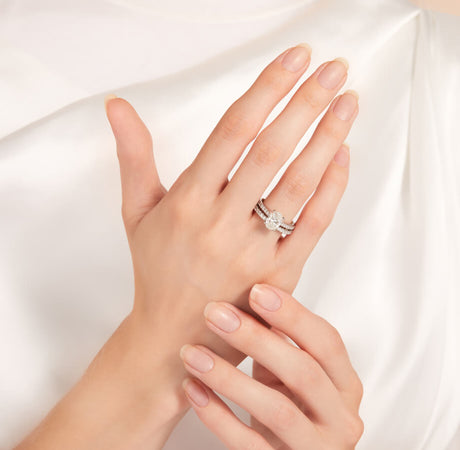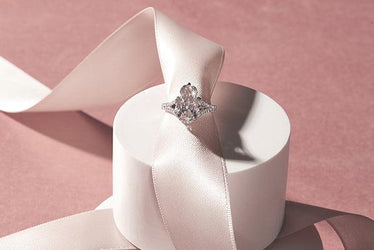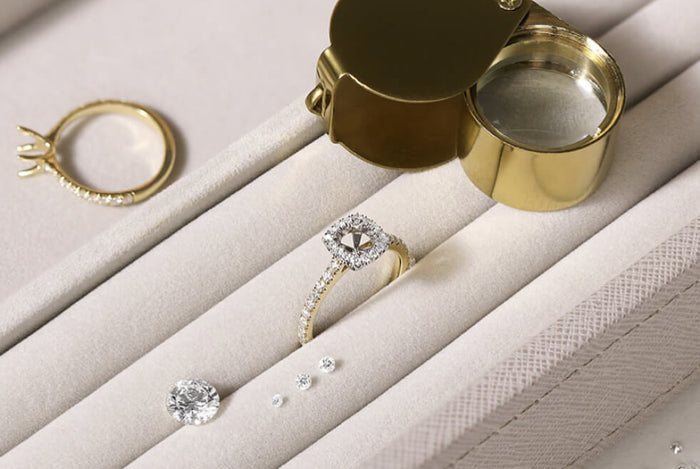Choosing the Right Diamond for You
Lab grown diamonds stand alongside natural diamonds in today's fine jewellery world, sharing identical chemical properties yet different origins. One emerges from Earth's depths over billions of years, while skilled artisans create the other in specialised laboratories. Many of our clients visit our Hatton Garden showroom seeking clarity about these two remarkable choices.
Our heritage as London jewellers spans generations, giving us deep insight into both natural and laboratory-created diamonds. Clients often pause at our design counter, diamond in hand, asking about authenticity, lasting value, and the story behind each stone. Drawing from 75 years of expertise in Britain's diamond quarter, we offer clear guidance to help you choose the perfect diamond for your piece.
Perfect Diamonds from Modern Labs
Master craftsmen in specialised laboratories create diamonds that match nature's finest gems. Our qualified GIA gemmologists confirm these stones share identical properties with mined diamonds - from crystal structure to physical characteristics. Each gem emerges from carefully controlled chambers where precise conditions mirror Earth's diamond-forming environment.
Diamonds, diamonds, diamonds - beautiful in every cut, colour, clarity and now in the way in which they are sourced. You may have become increasingly familiar with the term ‘lab-made diamonds’ over the past few years as the powers of nature and technology have magically collaborated.
Lab-made refers to diamonds that have been grown in a highly controlled laboratory environment in order of producing beautiful and sparkly diamonds with one huge difference - they haven't been mined.

Nature's Recipe in Modern Hands
Picture a diamond growing chamber - a masterpiece of engineering that recreates the exact pressure and heat found deep within Earth's crust. Here, laboratory diamonds take shape under watchful eyes. Once formed, these gems pass through the same journey as natural stones - expert cutting, careful polishing, and thorough grading.
These modern marvels shine with remarkable consistency. The stable growing environment yields stones with fewer natural birthmarks than their earth-grown cousins. Each diamond emerges with exceptional clarity, ready for setting in your chosen piece.
From Billions to Weeks: The Time Factor
Mother Nature takes billions of years to craft her diamonds. Modern laboratories achieve the same result in 6 to 10 weeks - perhaps their most remarkable achievement. Yet this shorter timeline takes nothing away from the diamond's quality.
Our diamond creation follows five essential stages:
- Initial crystal seeding
- Controlled growth under precise conditions
- Professional cutting and polishing
- Rigorous quality assessment
- Certification of origin
These gems hold true to every quality that defines a diamond. Think of the laboratory as nature's time machine - achieving in weeks what Earth accomplishes over millennia. The result? Stones that match their natural counterparts in every measurable way.
Each laboratory diamond comes with its own story, documented from first crystal to final polish. This clear history offers peace of mind to clients seeking complete clarity about their diamond's journey.

Our Gemmologists Compare Diamond Types
Our qualified GIA and Gem-A gemmologists spend countless hours studying both laboratory-created and natural diamonds under specialised equipment. Their findings reveal fascinating differences between these two remarkable gems, offering clear guidance for your choice.
Crystal Clear Perfection
Laboratory diamonds sparkle with exceptional clarity. Our design team often marvels at their pristine crystal structure - a result of carefully controlled growing conditions. These gems typically show fewer natural birthmarks than their earth-grown cousins, displaying remarkable visual perfection.
While both types share identical properties, laboratory stones consistently achieve outstanding quality grades. Each gem benefits from stable conditions throughout its creation, yielding stones of remarkable consistency and beauty.
Diamond Origins: The Paper Trail
Your diamond's story matters. Since even our expert eyes cannot tell laboratory and natural diamonds apart, proper certification becomes essential. Every laboratory diamond arrives with detailed papers proving its journey from creation to showcase.
Your certification includes:
- Complete chemical analysis
- Growth condition verification
- Quality grading details
- Origin confirmation
Think of certification as your diamond's passport - a detailed record of its journey from first crystal to final polish. This clear history offers peace of mind, particularly valuable when choosing laboratory diamonds.
Both gem types face identical scrutiny under our gemmologists' careful eyes. We grade cut, colour, and clarity using the same exacting standards. Laboratory stones often achieve exceptional grades, backed by certificates that confirm both quality and origin.
Our years in Hatton Garden have shown that laboratory diamonds match natural ones in every essential quality. The real difference lies not in what they are, but in how they came to be. This gives you two equally genuine choices, each with its own remarkable story to tell.
Price Points: A Tale of Two Diamonds
Our daily conversations with clients reveal fascinating shifts in diamond prices. Natural and laboratory-created diamonds follow distinct paths in today's market, offering unique advantages for different priorities.
Natural Diamonds: The Premium Choice
Earth-grown diamonds command higher prices through simple rarity. These precious gems, born over billions of years, cannot be crafted at will. Their value stems from:
- Nature's limited supply
- Complex mining journeys
- Time-honoured traditions
- Proven value history
Laboratory Diamonds: Brilliant Value
Think of laboratory diamonds as fine art meeting science - identical beauty at gentler prices. While cut, colour and size affect cost, these gems typically offer more sparkle for your pound.
The value story makes perfect sense. Modern creation methods skip nature's lengthy timeline, bringing exceptional diamonds to life in mere weeks. This efficiency translates directly to your pocket.
Yet pause before viewing either choice purely through the investment lens. While natural diamonds often hold their value through scarcity, laboratory gems might see price changes over time. Both shine brightest as cherished pieces in your collection rather than items for future sale.
The market tells two distinct stories. Natural diamonds stand as traditional treasures, their value protected by limited supply. Laboratory diamonds sparkle as modern luxury, offering remarkable quality at 40-50% below natural diamond prices.
This price difference opens new possibilities. Picture choosing a larger, more striking stone while staying comfortably within budget. Add the peace of mind from knowing your gem's complete history, and laboratory diamonds present a compelling choice for today's conscious buyer.
Value Stories: Two Paths for Diamond Investment
Our years in Hatton Garden reveal fascinating patterns in diamond values. While natural and laboratory-created diamonds sparkle equally bright, their investment stories follow different paths.
Natural Diamonds: Time-Tested Treasures
Picture natural diamonds as nature's limited edition. These precious gems grow scarcer each year, their value often rising as availability shrinks. Earth holds only so many diamonds, making each stone a piece of our planet's finite treasure.
Think of natural diamonds as silent guardians of wealth. Through market ups and downs, these gems have shown remarkable staying power. Their centuries-old story of value makes them cherished additions to family collections.
Laboratory Diamonds: Modern Luxury Made Accessible
Laboratory diamonds write a different story. These remarkable gems match nature's beauty while offering genuine value. Today's prices sit 40-50% below natural diamonds of equal quality - a difference that opens new possibilities.
These modern marvels shine brightest in:
- Statement jewellery pieces
- Engagement rings
- Special occasion gifts
- Personal collections
Yet pause before viewing laboratory diamonds through the investment lens alone. While their emotional value grows with cherished memories, market prices might change over time. These gems excel as beloved pieces in your collection rather than items for future sale.
The choice becomes clearer when considering long-term plans. Natural diamonds stand as traditional stores of value, protected by their irreplaceable status. Laboratory diamonds offer immediate access to luxury, bringing exceptional quality within comfortable reach.
Our design counter wisdom suggests choosing laboratory diamonds for their beauty and value today. These gems bring remarkable quality to life's precious moments, perfect for buyers seeking affordable luxury without future resale concerns.
Your Perfect Diamond Choice
Our design counter welcomes countless stories of special moments. Each client brings unique dreams, whether drawn to natural and laboratory-created diamonds through different paths. Natural diamonds stand as precious heirlooms, their value safeguarded by Earth's finite treasure chest. Laboratory diamonds shine equally bright, bringing remarkable quality to life at gentler prices.
The perfect choice speaks to your heart's priorities. Natural diamonds whisper tales of tradition, ideal for those seeking time-tested value. Laboratory diamonds open doors to larger, equally stunning gems that respect both dreams and budgets.
Diamond choices grow richer as craft meets innovation. Visit our Hatton Garden showroom to explore both options properly. Hold each gem, learn its story, picture its place in your collection. Remember - whether born in Earth's depths or modern laboratories, these precious stones carry identical beauty. Your perfect choice simply waits to match your unique story.
FAQs
Q1. What are the main differences between lab-grown and natural diamonds?
Lab-grown and natural diamonds have the same chemical composition and physical properties. The key differences are their origin (lab vs earth), formation time (weeks vs billions of years), and price (lab diamonds are typically 40-50% less expensive). Natural diamonds may have more inclusions, while lab diamonds tend to be more flawless.
Q2. Do lab-grown diamonds hold their value over time?
Lab-grown diamonds generally do not hold their value as well as natural diamonds. Their prices have been declining as production increases. However, natural diamonds also depreciate after purchase. The resale value of both types depends on market conditions at the time of sale.
Q3. Are lab-grown diamonds considered "real" diamonds?
Yes, lab-grown diamonds are chemically, physically, and optically identical to natural diamonds. They are real diamonds, just created in a laboratory rather than mined from the earth. The only difference is their origin.
Q4. How can you tell if a diamond is lab-grown or natural?
It's nearly impossible to distinguish lab-grown from natural diamonds with the naked eye or even standard jeweller's tools. Specialised equipment in a gemological laboratory is required to definitively identify the origin. Both types of diamonds receive the same grading for cut, colour, and clarity.
Q5. Why do some people still prefer natural diamonds over lab-grown?
Some people prefer natural diamonds for their perceived rarity, the romance of their billion-year formation, and their traditional value as heirlooms. Others appreciate the uniqueness of natural diamonds' inclusions. However, preferences are changing as more consumers learn about and accept lab-grown diamonds.











